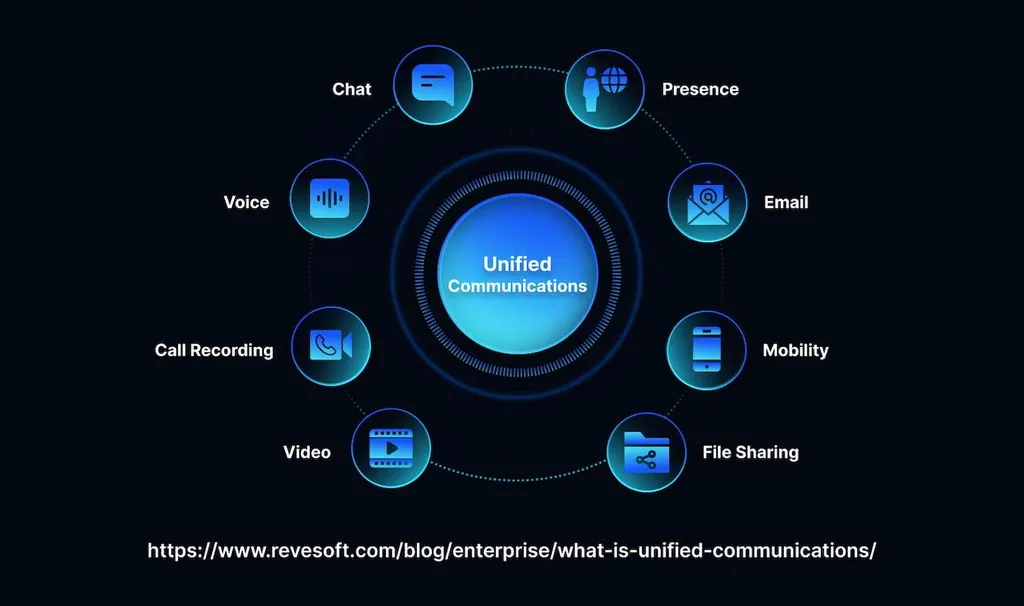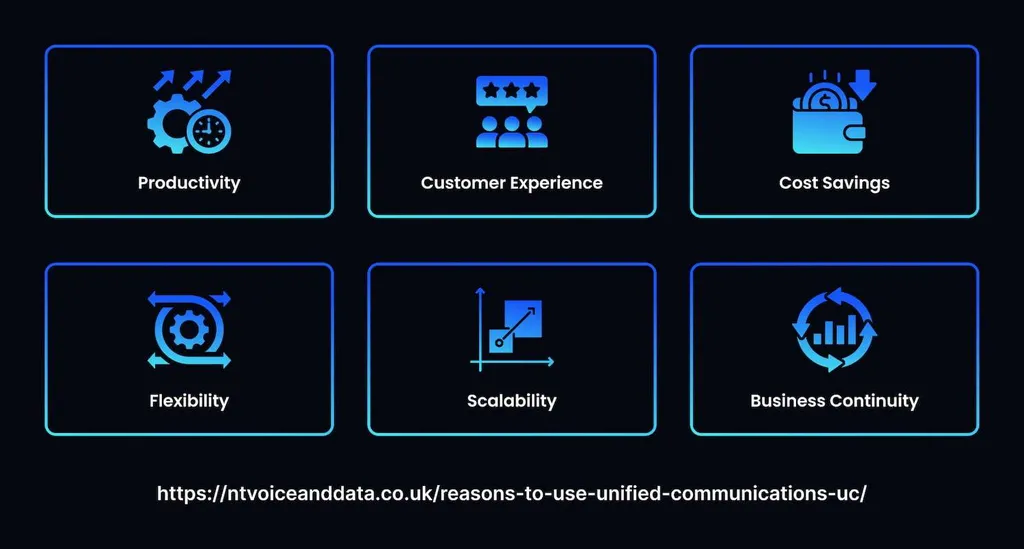Modern companies handle increasingly complex processes. They need to implement powerful systems to simplify collaboration between teams and boost productivity. Ventures rely on unified communications (UC) to develop advanced ecosystems comprising all sorts of tools. They use Zoom, Microsoft Teams, and other solutions to streamline cooperation. Firms deploy voice and video conferencing solutions, messengers, and other products to thrive in an evolving market environment. They utilize AI models to automate routines and optimize processes. In this guide, we will explore UC practices in detail to show how businesses use them to achieve sustainable growth.
What are Unified Communications?
UC is a set of practices developed to integrate and coordinate multiple communication channels, as well as deploy various tools and technologies within a single organization. The framework simplifies workspace and routines, permitting employees to access real-time communication software and asynchronous solutions using a centralized platform. Team members make voice and video calls, send chat messages, exchange emails, and share documents without compromising sensitive information.
Companies need to adopt more efficient approaches to adjust to swiftly changing environments. They use many apps and need to discover how to control them and manage data while maintaining full compliance. When building a new infrastructure, ventures must integrate communication solutions to enable employees to coordinate their efforts.
Legacy systems can no longer cope with the increasing demands of modern work processes. Companies want to optimize their expenses instead of bloating their staff to deal with increased demand during peak times. They deploy algorithm-based apps to automate routines and achieve a productivity boost.
UC is the term developed to describe a range of a firm’s communication capabilities. Ventures deploy traditional telephony and VoIP systems, handle requests made from mobile phones, analyze large amounts of data, and use cloud services to collect, organize, and store data.
UC products include hardware, software, and services, enabling ventures to interact with clients across different channels. They are typically integrated within larger systems to streamline business operations and augment user experience (UX).
Main UC Features

UC tools facilitate dealing with convoluted processes and routines. A complex UC system typically comprises multiple components:
- Instant messaging apps. They ensure information exchange in real time and enable staff members to discuss issues from any connected device.
- Video conferencing tools. Teams utilize such software to conduct meetings when working remotely. They use programs with in-built AI features designed to improve call quality, remove background noise, and simplify communication.
- Fluid presence solutions. Built to detect user presence across devices, they facilitate switching between different workspaces to streamline coordination between employees based in various locations.
- Softphones. Ventures switch to apps with lower bandwidth requirements to minimize capital expenditure. Per-user pricing strategies enable businesses to maintain control over expenses and pay only for the services they need.
Switching to Unified Communications as a Service (UCaaS) models enables firms to access cloud-based platform hosting messengers, videoconferencing software, and other tools. This approach is the best choice for enterprises with hybrid workforces. It permits teams to access a bundle of tools remotely instead of investing in costly on-premises hardware.
Benefits of Unified Communications

Businesses embrace agile approaches to simplify operations and boost profits. Here are the key upsides of implementing UC:
- Lower expenses and higher ROI. Organizations avoid making substantial investments in on-premises systems. They switch to cloud-based platforms to reduce operational costs and maintain flexibility. It permits them to estimate their spending with higher accuracy and reduce IT costs. Businesses adopting UC save on travel expenses and energy consumption.
- Workplace improvement. Firms leverage AI to translate texts in real time, transcribe videos automatically, and perform noise reduction. UC apps have excellent value for money, as they let firms analyze and streamline work patterns, improve employee satisfaction and focus time. UC apps ensure smooth collaboration between team members working from home or remotely.
- Business intelligence tools. Ventures analyze communication processes to detect patterns and identify potential areas for improvement. Managers use the collected insights to understand how each solution is used and develop better collaboration practices.
- Enhanced security and compliance. UC platforms rely on zero-trust architecture to prevent data leaks. They use end-to-end encryption to safeguard sensitive data and implement advanced mechanisms to protect clients and infrastructure against cyber threats. Businesses from heavily regulated industries also benefit from UC systems designed with automatic recording tools. It makes it easier to maintain compliance.
- Augmented customer experience (CX). Ventures achieve an edge over competitors by providing high-quality support across multiple channels and deploying advanced AI chatbots. Such virtual assistants are trained to detect sentiment and interpret consumer behaviors. They collect valuable information, helping firms improve every stage of a client’s journey.
- Improved scalability. UC sites permit ventures to access future-proof infrastructure and scale their operations. Companies use such a platform to access edgy technologies like AR/VR or IoT. API-first strategies facilitate integrating new services into the system to adjust their performance depending on current business needs.
UC facilitates enhancing communication by undergoing through complete digital transformation. Smart platforms become the cornerstone of success, enabling firms to adapt to the changing world.
How to Choose UC Solutions?
Companies often lack the resources to build custom UC systems from scratch and fine-tune their performance. When looking for ready-made products, one should consider such things:
- Integration with other communication apps. It should be possible to create a unified interface, allowing users to access all applications within the system. UC products empower organizations and allow them to increase productivity, save time, and make their routines agile. Employees should be able to run the apps from any device and location via a centralized dashboard.
- Intuitive functionality. The adoption process should not be too convoluted. Every person should understand how to deploy UC apps and make them a part of their routine. Complex features and interfaces hinder adoption.
- Regular updates. Users need to access up-to-date tools. Automated upgrades ensure that every person will be able to utilize recent features, adapted to the needs of a particular organization.
- Migration support. Enterprises need to choose relevant UC systems offered by reputable providers. Such vendors provide support and maintenance services, streamlining implementation.
When choosing UC products, consider whether they suit the particular needs of your organization. You may outsource fine-tuning such systems to trusted providers to save time and ensure their uninterrupted performance.
Main Ways to Use Unified Communications
Ventures adopt UC to reach specific objectives and transform routines. Here are the main applications of the framework:
- Creating resilient infrastructure for hybrid work. UC lets teams access powerful solutions available on-site and remotely. Such platforms facilitate deploying apps without compromising on security.
- Integrating a complex tech stack. UC is easy to access, irrespective of employee location. They let firms boost productivity and minimize downtime.
- Adopting AI. One can quickly launch chatbots, digital assistants, and sentiment analysis tools within a UC system. These products improve CX and allow employees to provide personalized services. GenAI tools streamline decision-making and let enterprises deploy intelligent digital agents.
- Replacing or upgrading legacy tools. UC facilitates transitioning to modern, advanced solutions that give organizations higher flexibility. Companies use them to augment the experiences of their frontline workers.
- Switching to Desktop as a Service (DaaS). This model involves creating a virtual desktop environment, integrating the OS, apps, and files. Users can access a cloud-based desktop from laptops or smartphones with ease. Vendors provide such services to clients who pay for a subscription. One pays only for the resources they use.
Ventures still have to utilize many office-based apps, requiring installation. However, self-service models enable them to increase the efficiency of their workflows. They save funds on DaaS, as they no longer need to buy expensive hardware and pay high office rent. UC makes experiences intuitive and enables distributed teams to collaborate in new ways. This strategic shift lets teams adopt AI to automate tasks and focus on high-priority projects.
Emerging UC Trends
The development of AI and the widespread implementation of hybrid work processes changed the way companies use UC platforms. Market leaders need to understand the current transformation better to capitalize on recent developments.
- AI Agents. Teams implement digital helpers to simplify routines. Metadialog builds enterprise-level solutions designed to increase team productivity by 5 times. The provider builds a custom LLM capable of automating up to 81% of replies to queries. AI assistants schedule meetings, translate text, write code, and reduce workload.
- GenAI. The technology has changed the way companies create content. LLMs assist managers with writing emails and keeping documentation free of any mistakes. Their capabilities permit teams to maintain consistent quality when solving queries across various channels.
- Hybrid workspaces. Employees often work partly from home, and organizations need to provide them with safe access to dashboards and tools by implementing updated collaboration features.
- Open APIs. UC platforms expedite business processes. They become part of unique workflows and support integration with all sorts of apps. High interconnectivity ensures that there won’t be any silos hindering productivity.
- AI collaboration spaces. Algorithm-driven cameras and digital whiteboards simplify meetings between participants in different locations.
- Cloud migration. Enterprises switch to cloud-based UC systems to remain flexible and scale at lower cost. It permits them to make their infrastructure future-proof and avoid costly upgrades.
- Advanced compliance tools. Ventures use UC to improve retention, streamline auditing, and make data control transparent. It simplifies working in highly regulated industries or expanding operations globally.
Unified communications and collaboration systems are all about augmenting staff experience and improving engagement. Firms deploy dedicated tools to assess fatigue, promote inclusion, and simplify work patterns. A strong omnichannel presence enables teams to solve queries with ease. AI bots route complex tasks to human agents, answer simple requests automatically, and ensure consistent experiences across all consumer touchpoints.
Metadialog develops advanced AI solutions designed to simplify unified communications and foster collaboration. Custom-built systems enable teams to analyze client moods, see project deadlines, access notes, collect data, and perform other tasks. AI models eliminate language barriers and enhance product accessibility. They handle increased volumes of requests without consuming significant resources. Get in touch with our team and implement the latest solutions to improve your communication patterns.
